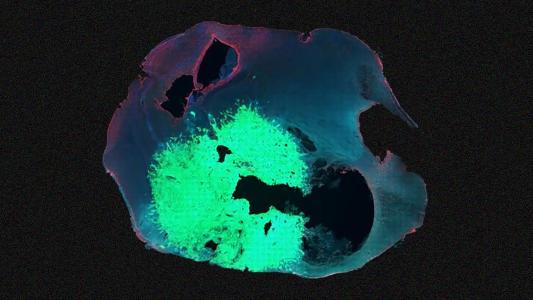A new gene therapy that reprograms cells to their younger state reversed vision loss in primates, according to a new study — potentially signaling a new era in the treatment of age-related diseases.
The challenge: Non-arteritic anterior ischemic optic neuropathy (NAION) is a condition caused by decreased blood flow to the optic nerve, resulting in sudden, significant, and usually permanent loss of vision in the eye.
Scientists aren’t sure what causes NAION, but most of the 6,000 Americans diagnosed with it every year are over the age of 50. There’s no known treatment, and people who develop NAION in one eye are at risk of developing it in the other.
NAION results in sudden, significant, and usually permanent loss of vision in the eye.
What’s new? Researchers from Harvard Medical School and Life Biosciences, a Boston-based biotech company, have announced the development of a gene therapy that reversed vision loss in primate models of NAION — by making their eye cells “young” again.
“We are delighted to present this truly groundbreaking data, which further validate Life Bio’s innovative approach to cellular rejuvenation,” said Sharon Rosenzweig-Lipson, CSO of Life Bio.
The background: Chemical compounds attached to DNA, called “epigenetic marks,” help determine which genes in a cell are on (“expressed”) and which aren’t.
These marks can change over time, so genes that might be on when we’re young can turn off as we get older and vice versa. Often, these changes are for the worse, leading to signs of aging and the development of age-related diseases.
The gene therapy reprograms cells to a time before age led to any unwanted epigenetic changes.
In 2006, Japanese researchers discovered that increasing the expression of four genes — Oct4, Sox2, Klf4, and c-Myc (collectively, OSKM or “Yamanaka factors,” after the scientist who discovered them) — allowed them to reprogram cells back to their embryonic state, even to the point where they become stem cells.
More recently, researchers have found that they could use Yamanaka factors to partially reprogram cells, back to a time after they became specialized adult cells but before age led to any unwanted epigenetic changes.
Past studies have demonstrated how this partial reprogramming with Yamanaka factors can extend the lives of old mice and restore sight in mouse models of glaucoma. And now, the Life Bio team has demonstrated that it can restore sight in primate models of NAION.
The gene therapy: For their study, presented at the Association for Research in Vision and Ophthalmology (ARVO) 2023 conference, the Life Bio team used a modified virus as a carrier for the genes that tell cells to produce three Yamanaka factors (OSK).
They designed the treatment so that the expression of these genes could be induced with the administration of the antibiotic doxycycline — this essentially gave them an on-off switch for the therapy.
“This approach has implications far beyond NAION and even the vision field.”
Sharon Rosenzweig-Lipson
To test it, they used lasers to damage the eyes of 10 non-human primates in a way that is similar to NAION. The following day, they injected the gene therapy into the eyes of six primates and a control solution into the eyes of the other four.
They administered doxycycline to all of the animals for the duration of the five-week study and periodically checked how their retinas responded to light using an objective test, called a “pattern electroretinogram” (pERG). They also measured the number of healthy axon bundles in the animals’ eyes.
The animals that got the gene therapy did significantly better than the control group on the pERG test, and they demonstrated a significant improvement in the number of healthy nerve bundles — developments the researchers say are consistent with restored vision.
Looking ahead: While it’s not clear how long the effects of the treatment last, study co-leader Bruce Ksander told Fierce Biotech he believes the therapy could be delivered repeatedly if necessary to sustain the results.
The results of the study haven’t been published, but if they hold up under peer-review, a successful primate study would be the best evidence yet that partial reprogramming is a viable means of treating aging-related diseases.
“This approach has implications far beyond NAION and even the vision field, and we are pleased to share data that support the continued development of our scientific platform to address diseases of aging and restore human health,” said Rosenzweig-Lipson.
We’d love to hear from you! If you have a comment about this article or if you have a tip for a future Freethink story, please email us at [email protected].






